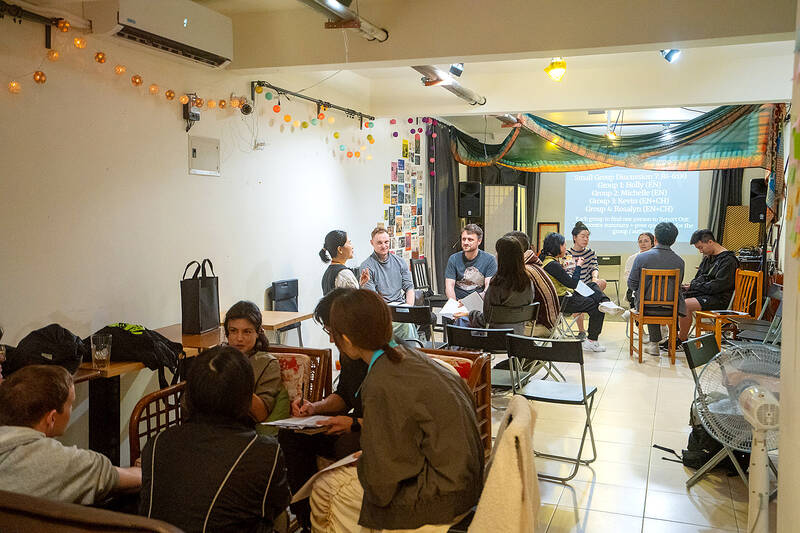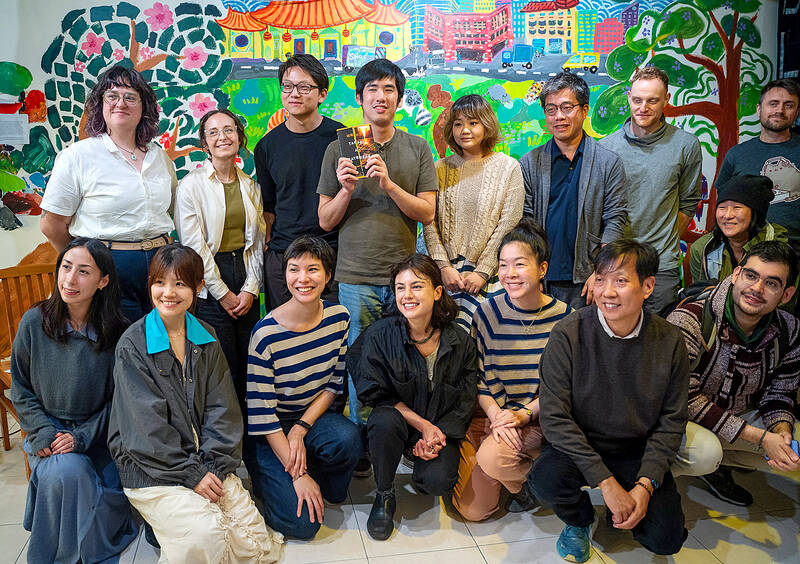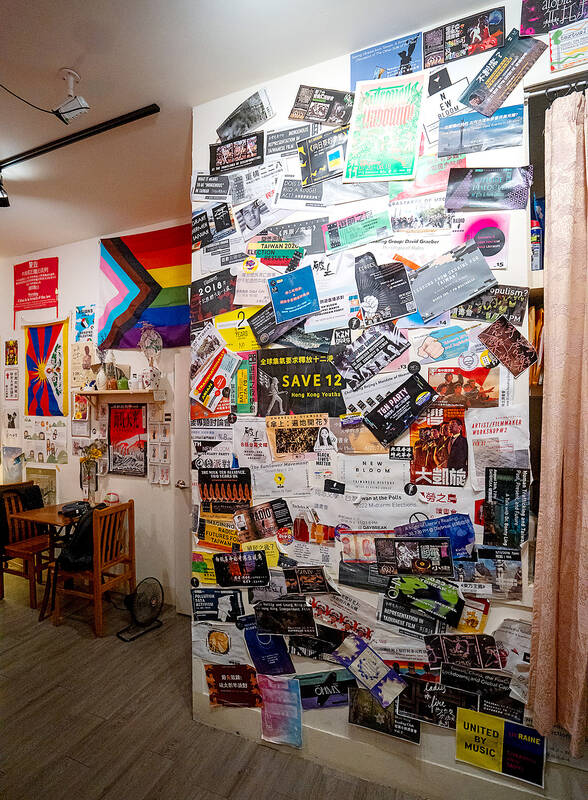Brian Hioe says that New Bloom started out as a group of like-minded youth activists that eventually transformed into a publication, a project detailing the Sunflower movement’s oral history and now an event space where all manner of passionate individuals come together to discuss pressing issues facing Taiwan.
“New Bloom happened because a couple of people talked at a protest,” Hioe says.
We’re sitting in a cafe in Taipei, surrounded by affirmations of Taiwanese identity and sovereignty, discussing Hioe’s new novel, Taipei at Daybreak, a fictionalized account of his own participation in the Sunflower movement in 2014.

Photo: Lery Hiciano, Taipei Times
The following week, Hioe answers questions from readers during a reading club event at Daybreak, a local cafe and social club for New Bloom, a magazine that he and several fellow activists founded in the aftermath of the Sunflower movement.
At Daybreak, one might see a local independent candidate running for city council, an expert on survival tactics, a pro-trans fundraising event or a talk on the difficulties faced by Taiwan’s Southeast Asian laborer population.
Hioe and New Bloom are unapologetic in the causes they support and the politics they wear on their sleeves, the walls adorned with flags and posters of everything from White Terror remembrance events to Ukraine-inspired drinks on the menu.

Photo: Lery Hiciano, Taipei Times
Hioe’s new book, much like everything else New Bloom does, is at the intersection of youthful idealism about how the world should be and its harsh realities.
Following a launch event for his novel, Hioe spoke to the Taipei Times about the writing process, the importance of memory in defining identity and his role as a conduit within Taiwan’s activism scene.
THE WRITING PROCESS

Photo: Lery Hiciano, Taipei Times
Starting in 2017 and 2018, Hioe began to write what later became Taipei at Daybreak, using his excerpts of earlier works dating back to as early as 2011 when he was just starting to enter the world of social activism.
“Everything that happens to the protagonist is something that happened to me,” Hioe says, although he mentions he made changes for the sake of narrative.
The book, written using material from both the time of the movement and later additions, is an “odd dialogue of myself,” Hioe says.
To Hioe, the book is a testament to how much Taipei has changed.
“The memory of the Sunflower movement is gone,” he says. Three consecutive presidential elections have gone in favor of the Democratic People’s Party (DPP), Taiwanese identity as something distinct from China has become much more mainstream and tensions between Washington and Beijing have focused international attention on Taipei in a way that was unimaginable when the movement first started.
SOCIAL MEMORY AND IDENTITY
Hioe says the book is about waishengren (外省人) identity, or the identity of those who fled to Taiwan after the Chinese Nationalist Party (KMT) lost the Chinese Civil War in 1949. The KMT ruled over the island with an iron fist for most of the following four decades.
Hioe says his protagonist descended from waishengren, adding that he’s fascinated by the idea that a victim can also be a victimizer. “That reflects my own family’s history,” he says.
Much of Taiwan’s literary history and the works that historically gained international attention have been the work of waishengren authors, he says.
From the novel’s first page, the main character’s push and pull between Chinese and Taiwanese identity is frequent, culminating in a climactic inward look on how he declares he may “revenge myself upon my own past and all those who had suffered under us.”
It is a stark example of Hioe’s views on the cyclical nature of societal trauma, and where all must eventually come to terms with their own complicated inheritances.
“I’m very sympathetic to that sense of trauma, but then from that trauma you often just become another victimizer,” he says.
He added that the “vacuum” of trauma has “still not been filled.”
While the protagonist considers violent outcomes to solve the issue, Hioe himself has participated in primarily peaceful movements.
“Part of what I am trying to get at with this novel is the sense of desperation that pushed people into the legislature, take such a desperate act, breaking the law, fighting with the police ... And we’ve forgotten that.”
In this cafe, sitting under a snake drawing on the wall charting out Taiwan’s democratization throughout the 20th century, Hioe says, “this place is where the characters in the novel meet after the incident at the [legislature].”
Placing the novel within the context of increasing attention on Taiwanese stories, from movies such as Didi to other novels like the Taiwan Travelogue, Hioe admitted that this is a “moment,” but admitted he sees this book as more about Taiwan than about the Taiwanese diaspora of which he is a part.
It is part of a larger balancing act he finds himself trying to perfect, living in Taipei while primarily writing in English for an audience that is not very local. Daybreak, as a space, often attracts Taiwanese who lived or grew up abroad, as well as ex-pats interested in the local culture but not always a part of it.
“In the early 2010s, there was a lack of knowledge of Asia, which has changed a lot […] There is a struggle for identity that’s part of it, but that’s not what I was thinking of when I wrote it. I wanted to be grounded in the historical moment, but also the city. This city of protests,” Hioe says.
Although the book, as he said, is in many ways about identity, social movements, and his own experiences, Taipei is as much of a character as any of the humans. He names streets, landmarks, sights and smells that are familiar to residents, even if they describe locations that have moved, closed or have changed with the times.
Yet Hioe remains focused on Taipei’s memory, not as an imagined past or a source of nostalgic pain, but as a living entity that carries memories of its past. It is why the same week as he launched his book and spoke to the Taipei Times, he led a group on a walking tour of Zhongzheng District (中正), teaching participants about the 228 Incident and what occurred on those streets generations before that still resonates to the present day.
“One change I’d like to see in Taiwan? Dissolve the KMT,” Hioe says.

The People’s Republic of China (PRC) last week offered us a glimpse of the violence it plans against Taiwan, with two days of blockade drills conducted around the nation and live-fire exercises not far away in the East China Sea. The PRC said it had practiced hitting “simulated targets of key ports and energy facilities.” Taiwan confirmed on Thursday that PRC Coast Guard ships were directed by the its Eastern Theater Command, meaning that they are assumed to be military assets in a confrontation. Because of this, the number of assets available to the PRC navy is far, far bigger

The 1990s were a turbulent time for the Chinese Nationalist Party’s (KMT) patronage factions. For a look at how they formed, check out the March 2 “Deep Dives.” In the boom years of the 1980s and 1990s the factions amassed fortunes from corruption, access to the levers of local government and prime access to property. They also moved into industries like construction and the gravel business, devastating river ecosystems while the governments they controlled looked the other way. By this period, the factions had largely carved out geographical feifdoms in the local jurisdictions the national KMT restrained them to. For example,

The remains of this Japanese-era trail designed to protect the camphor industry make for a scenic day-hike, a fascinating overnight hike or a challenging multi-day adventure Maolin District (茂林) in Kaohsiung is well known for beautiful roadside scenery, waterfalls, the annual butterfly migration and indigenous culture. A lesser known but worthwhile destination here lies along the very top of the valley: the Liugui Security Path (六龜警備道). This relic of the Japanese era once isolated the Maolin valley from the outside world but now serves to draw tourists in. The path originally ran for about 50km, but not all of this trail is still easily walkable. The nicest section for a simple day hike is the heavily trafficked southern section above Maolin and Wanshan (萬山) villages. Remains of

With over 100 works on display, this is Louise Bourgeois’ first solo show in Taiwan. Visitors are invited to traverse her world of love and hate, vengeance and acceptance, trauma and reconciliation. Dominating the entrance, the nine-foot-tall Crouching Spider (2003) greets visitors. The creature looms behind the glass facade, symbolic protector and gatekeeper to the intimate journey ahead. Bourgeois, best known for her giant spider sculptures, is one of the most influential artist of the twentieth century. Blending vulnerability and defiance through themes of sexuality, trauma and identity, her work reshaped the landscape of contemporary art with fearless honesty. “People are influenced by